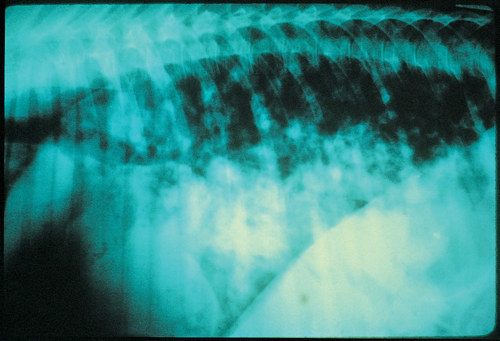Difference between revisions of "Equine Internal Medicine Q&A 17"
Ggaitskell (talk | contribs) (Created page with "{{Template:Manson Mair}} centre|500px<br> <br /> '''A 10-week-old foal in good body condition showed signs of acute dyspnoea.''' ...") |
|||
| (One intermediate revision by one other user not shown) | |||
| Line 13: | Line 13: | ||
|a1=Lateral view of the thorax demonstrates nodular lesions in the cranioventral lung fields. These lesions, some of which are cavitary, obscure the cardiac and caudal vena cava silhouette. <br><br> | |a1=Lateral view of the thorax demonstrates nodular lesions in the cranioventral lung fields. These lesions, some of which are cavitary, obscure the cardiac and caudal vena cava silhouette. <br><br> | ||
Tracheobronchial lymphadenopathy is suggested by the elevation of the trachea. | Tracheobronchial lymphadenopathy is suggested by the elevation of the trachea. | ||
| − | |l1= | + | |l1= Rhodococcus equi#Diagnosis |
|q2=What is the most likely aetiologic agent? | |q2=What is the most likely aetiologic agent? | ||
|a2= | |a2= | ||
Radiographic lesions of this type seen in a 10-week-old foal are almost pathognomonic for ''Rhodococcus equi'' infection. | Radiographic lesions of this type seen in a 10-week-old foal are almost pathognomonic for ''Rhodococcus equi'' infection. | ||
| − | |l2= | + | |l2=Rhodococcus equi |
|q3=What is the source of the infection for the foal? | |q3=What is the source of the infection for the foal? | ||
|a3= | |a3= | ||
| Line 23: | Line 23: | ||
''Rhod. equi'' lives in faeces and soil and is resistant to most chemical and environmental conditions. The organism is found in the intestines of many normal mammals including horses. <br><br> | ''Rhod. equi'' lives in faeces and soil and is resistant to most chemical and environmental conditions. The organism is found in the intestines of many normal mammals including horses. <br><br> | ||
Foals are most often infected by inhalation of the organism from the soil or faeces of the animals, but ingestion or umbilical entry are also possible. | Foals are most often infected by inhalation of the organism from the soil or faeces of the animals, but ingestion or umbilical entry are also possible. | ||
| − | |l3= | + | |l3= Rhodococcus equi#Introduction |
|q4=What is the recommended treatment? | |q4=What is the recommended treatment? | ||
|a4=Treatment of ''Rhod. equi'' has been difficult due to the intracellular characteristics of the organism. <br><br> | |a4=Treatment of ''Rhod. equi'' has been difficult due to the intracellular characteristics of the organism. <br><br> | ||
| Line 31: | Line 31: | ||
Rifampin is synergistic with erythromycin and penetrates macrophages, neutrophils and caseous material readily. | Rifampin is synergistic with erythromycin and penetrates macrophages, neutrophils and caseous material readily. | ||
*Rifampin is dosed at 5mg/kg p/o bid, although some clinicians use 10mg/kg p/o sid. | *Rifampin is dosed at 5mg/kg p/o bid, although some clinicians use 10mg/kg p/o sid. | ||
| − | |l4= | + | |l4=Rhodococcus equi#Treatment and Control |
| − | |||
| − | |||
</FlashCard> | </FlashCard> | ||
Latest revision as of 15:12, 8 July 2011
| This question was provided by Manson Publishing as part of the OVAL Project. See more Equine Internal Medicine questions |
A 10-week-old foal in good body condition showed signs of acute dyspnoea.
| Question | Answer | Article | |
| Describe the radiographic findings illustrated in the image. | Lateral view of the thorax demonstrates nodular lesions in the cranioventral lung fields. These lesions, some of which are cavitary, obscure the cardiac and caudal vena cava silhouette. Tracheobronchial lymphadenopathy is suggested by the elevation of the trachea. |
Link to Article | |
| What is the most likely aetiologic agent? | Radiographic lesions of this type seen in a 10-week-old foal are almost pathognomonic for Rhodococcus equi infection. |
Link to Article | |
| What is the source of the infection for the foal? | Rhod. equi is a Gram-positive, pleomorphic, facultative, intracellular, obligate aerobic bacteria. |
Link to Article | |
| What is the recommended treatment? | Treatment of Rhod. equi has been difficult due to the intracellular characteristics of the organism. The combination of erythromycin and rifampin is excellent in vitro and has decreased the mortality rate associated with Rhod. equi pneumonia.
Rifampin is synergistic with erythromycin and penetrates macrophages, neutrophils and caseous material readily.
|
Link to Article | |
